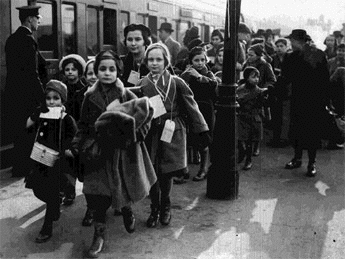|
Introduction
Kindertransport is also known as Refugee Children Movement,
which was a rescue mission that took place nine months before
the outbreak of World War II. The United Kingdom took mainly
Jewish children from Nazi Germany and occupied territories of
Austria, Czechoslovakia and the Free City of Danzig.
Lola Hahn-Warburg set the
framework of rescue in 1933; Lord Baldwin, author of the famous
appeal to British conscience; Rebecca Sieff, Sir Wyndham Deeds,
Viscount Samuel; Rabbi Solomon Schoenfeld, Nicholas Winton,
Professor Bentwich, organizer of the Dutch escape route; and the
Quaker leaders Bertha Bracey and Jean Hoare, who herself led out
a planeload of children from Prague; and many others. Truus
Wijsmuller-Meyer was a Dutch Christian who faced down Eichmann
in Vienna and brought out 600 children on one train, organized a
transport from Riga to Sweden, and helped smuggle a group of
children onto the illegal ship Dora bound from Marseilles to
Palestine. She was the one who sped the last transport through
burning Amsterdam to the Bodegraven in 1940. |
 |
|
The Beginning
First Kindertransport arrived at Harwich, England on December 2,
1938. It brought 196 children from a Berlin Jewish orphanage
torched by the Nazis during the night of November 9. Most of the
transports left by train from the major cities, crossed the
Dutch and Belgian borders, and went on by ship to England.
Hundreds of children remained in Belgium and Holland. The
transports ended with the outbreak of war in September 1939.
Last transport left on the freighter Bodegraven from Ymuiden on
May 14, 1940. The 80 children on deck had been brought by
earlier transports to imagined safety in Holland. The
Kindertransports saved approximately around 10,000 children,
most of them Jews, from Germany, Austria, Czechoslovakia and
Poland.
There was an effort to deal with the issue of Jews trapped in
Hitler’s Reich, but countries were not willing to offer them
refuge - a conference proposed by President Roosevelt was held
in the French resort town of Evian, attended by representatives
from 31 countries. In July, 1938, the Evian Conference proved to
be ineffectual, as most countries continued their refusal to
accept new immigrants.
A Change in Stance
During the pogrom of November 9
and 10, German and Austrian Nazis killed nearly 100 Jews and
thousands more were exposed to violence and torture. 267
synagogues and community buildings were destroyed. Tens of
thousands of Jewish shops and homes were broken into and over
30,000 Jewish men were arrested and sent into concentration
camps. The refuge aid committees in Britain changed their
stance, attempting to rescue the children. The British
government had just refused to allow 10,000 Jewish children to
enter Palestine. The atrocities in Germany and Austria, untiring
persistence of refuge advocates, and sympathy towards Jews in
some high places helped to sway the government – unspecified
number of children below 17 years were allowed to enter United
Kingdom. British Foreign Minister Samuel Hoare “Here is a
chance of taking the young generation of a great people, here is
a chance of mitigating to some extent the terrible suffering of
their parents and their friends” Many organizations and
individuals assisted in settling the Kinder in the United
Kingdom, for example the Refugee Children’s Movement, various
youth movements, the Y.M.C.A., the Society of Friends, and many
other Jewish and non-Jewish organizations. Children of the
Kindertransport were dispersed to many parts of the British
Isles. About half lived with foster families, the others in
hostels, group homes, and farms in England, Scotland, Wales and
Northern Ireland. Those over 14 were frequently absorbed into
the country’s labor force after a few weeks of training,
mainly in agriculture or domestic service. During the fifth
column scare in 1940, more than 1,000 Kindertransportees over
16, boys and girls, were interred on the Isle of Man and other
sites. Some boys were transported to Canada, some to Australia
aboard the “hell-ship” Dunera. After German U-boats sank the
Andorra Star with 1,200 internees with loss of 600 lives, public
pressure built against further indiscriminate internment. A
large number of the deported came back, and along with many
young men and women who had stayed in Britain,
Kindertransportees joined the army.
Lucia Suhanyiova
British International School of Bratislava |